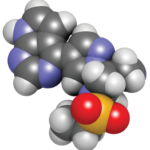
Cancer cells
As rheumatologists, we understand that any immunosuppressant treatment may theoretically increase the risk of cancer because the immune system does more than just protect against infection. It protects us against all things foreign—cancer included. Thus, immunosuppressants may impede the immune system’s ability to surveil and protect against both infections and tumors.
Are some biologic and targeted-synthetic disease-modifying anti-rheumatic drugs (DMARDs) riskier than others?
In 2022, the post-marketing ORAL Surveillance study demonstrated an increased incidence and risk of cancer in patients with RA receiving the Janus kinase inhibitor (JAKi) tofacitinib, compared with tumor necrosis factor (TNF) inhibitors.1 Of note, patients in ORAL were older than 50 years and had at least one other risk factor for cardiovascular disease. However, these results raised concerns about the safety of JAK inhibitor use in patients with RA in general.
Additional studies have since shown conflicting results. Some have confirmed the ORAL Surveillance study’s findings of an increased risk with JAK inhibitors, while others have shown no increased risk.2,3 What’s more, their generalizability for patients with RA in the U.S. is limited.
Therefore, Sendaydiego et al. sought to assess the comparative safety of TNF inhibitors, non-TNF inhibitors and JAK inhibitors for the risk of incident cancer in patients with RA using U.S. administrative claims data. Their findings were published in JAMA Network Open in November 2024.4
Methods
This retrospective cohort study included more than 25,000 patients with RA, aged 18–64 years. Patients were identified using U.S. administrative claims data from the Merative Marketscan Research Database, “which contains inpatient, outpatient and pharmacy claims data for hundreds of millions of patients covered by employer-sponsored commercial health insurance throughout all U.S. states and territories.” Patients had at least two RA diagnostic codes on or before the initiation of a biologic or targeted syntheticDMARD.4
Patients older than 65 years were excluded from the study because the majority of this age group is predominantly covered by Medicare, and researchers did not have access to those claims. Patients with any prior cancer diagnosis—except for non-melanoma skin cancer—were also excluded due to the uncertainty of attributing cancer recurrence to a natural progression of disease as opposed to a drug-induced side effect.
The majority of study patients were women from the southern U.S. with a median age of 50. a Biologic or targeted synthetic DMARD exposures included TNF inhibitors (74%), JAK inhibitors (9%), abatacept (8%), rituximab (4%) and interleukin (IL) 6 inhibitors (4%). Patients were allowed to switch treatments if needed, per typical clinical practice patterns.
The primary outcome was incident cancer—excluding nonmelanoma skin cancer—between 90 days and two years of initiating a biologic or targeted synthetic DMARD. If a patient developed cancer, researchers associated it with the most recent drug exposure.
Multivariable Cox proportional hazards regression analysis showed that rituximab was associated with a higher risk of incident cancer compared with TNF inhibitors (hazard ratio [HR], 1.91; 95% confidence interval [CI], 1.17–3.14). This finding was followed by abatacept (HR 1.47; 95% CI 1.03–2.11) and JAK inhibitors (HR 1.36; 95% CI, 0.94–1.96).
Given the limitations of administrative claims data and confounding by indication, it was likely these patients had a higher disease burden, resulting in channeling bias (more details below).5
Implications for Clinical Practice

Dr. Singh
Namrata Singh, MD, MSCI, FACP, assistant professor, Division of Rheumatology, University of Washington, Bellevue, was a co-author of the current study. She was kind enough to share her take on the clinical implications of this fascinating research with The Rheumatologist.
The Rheumatologist (TR): Keeping the limitations of the study in mind, what should practicing rheumatologists take away from these findings?
Dr. Singh (NS): In our study, we observed a higher risk of incident cancers in patients using rituximab and abatacept relative to those on TNF inhibitors in the first two years of initiating treatment. I would emphasize the need for age-appropriate cancer screening, at a minimum, in our patients with RA given the increased risk of certain cancers.
Future studies are needed with longer follow-up and attention to minimize channeling bias to provide data on the long-term safety of our therapies.
TR: Can you explain what is meant by channeling bias in this study in plain English?
NS: Really good question. [Channeling] is a bias that can be introduced in observational studies when the exposure of interest was not assigned, as would [happen] in a randomized controlled trial.
Channeling bias arises when patients at risk for the outcome of interest are assigned a treatment that we believe will be safer or better for someone with the outcome. For example, in our study, we observed relatively sicker patients—who may be at high risk of cancer to begin with—being prescribed rituximab, and we, indeed, observed a higher cancer risk in rituximab users. Is this observation because rituximab increased the cancer risk, or was there channeling bias in prescribing the medication to those already at high risk for cancer?
TR: Does this study affect the way you prescribe biologics for your own patients? If so, how? If not, why not?
NS: It does. I am cautious about weighing the risk and benefits of starting or continuing biologic or targeted syntheticDMARDs in my patients with RA in the context of their disease activity [and] their baseline risk of cancer, as well as their priorities for overall health.
TR: What can’t this study tell us?
NS: Several things, actually. Our study had short follow-up, so it can’t [be used to] comment on long-term safety. And being a retrospective study, there are some inherent limitations in the study design, such as channeling bias and unmeasured confounding.
TR: What research needs to be done next?
NS: To understand these associations better, larger studies with longer follow-up and more granular collection of data, including medication indications and RA disease activity measures, would be needed for better a comparison of incident cancer risk among these drugs. Additional studies that can supplement observational pharmacoepidemiologic studies include:
- Post-marketing surveillance studies;
- Additional phase 4 clinical trials that provide head-to-head comparisons between JAK inhibitors and different biologics with intention-to-treat analyses; and
- Meta-analyses comparing studies from the U.S. with international databases.
Conclusion
Biologic or targeted synthetic DMARDs have changed the prognostic landscape for people living with RA in the best of ways, but they are not without risk. Studies like these help us better understand those risks so we can prescribe the therapies most likely to be safest for our patients.
Samantha C. Shapiro, MD, is a clinician educator who is passionate about the care and education of rheumatology patients. She writes for both medical and lay audiences and practices telerheumatology.
References
- Ytterberg SR, Bhatt DL, Mikuls TR, et al. Cardiovascular and cancer risk with tofacitinib in rheumatoid arthritis. N Engl J Med. 2022 Jan 27;386(4):316–326.
- Huss V, Bower H, Hellgren K, et al. Cancer risks with JAKi and biological disease-modifying antirheumatic drugs in patients with rheumatoid arthritis or psoriatic arthritis: A national real-world cohort study. Ann Rheum Dis. 2023 Jul;82(7):911–919.
- Khosrow-Khavar F, Desai RJ, Lee H, et al. Tofacitinib and risk of malignancy: Results from the safety of tofacitinib in routine care patients with rheumatoid arthritis (STAR-RA) study. Arthritis Rheumatol. 2022 Oct;74(10):1648–1659.
- Sendaydiego X, Gold LS, Dubreuil M, et al. Use of biologic or targeted synthetic disease-modifying antirheumatic drugs and cancer risk. JAMA Netw Open. 2024 Nov 4;7(11):e2446336.
- Petri H, Urquhart J. Channeling bias in the interpretation of drug effects. Stat Med. 1991 Apr;10(4):577–581.

